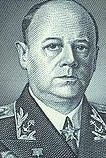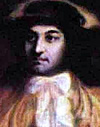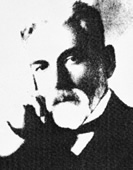Glossary (Isahakian, Avetik – Khanate of Karabakh)
Isakhakian, Avetik
 Avetik Isahakian
Avetik Isahakian
(1875-1957) Armenian lyric poet, native of Giumry. His poems are those of love and sorrow. His best work is Abdul Ala Mahari.
Isaiah, Prince of Dizak
(Abu-Musse) Armenian prince of Dizak, who organized heroic resistance of Artsakh province against the Arabs in 852.
Isakov, Ivan
 Admiral Ivan Isakov
Admiral Ivan Isakov
(1894-1967) Admiral of USSR Navy, member of Academy of Science of Armenia and member of Union of Soviet writers.
Israel Ori
 Israel Ori
Israel Ori
(1659-1711) Armenian patriot, diplomat and military. From 1678, he traveled several times throughout Europe and Russia trying to establish contacts with the leaders of the Christian powers. In order to find protection of Armenia against the Persians and Turks, he met with Leopold I in 1700, Peter the Great in 1701, and Clement XI in 1704. In 1709, he headed the Armenian delegation to the Persian Shah.
Kachaznuni, Hovannesi
 Hovannes Kachaznuni
Hovannes Kachaznuni
(1868-1938) Armenian political figure, member of The National Council in 1917 and First Prime Minister of the independent Republic of Armenia in 1918-1919. He emmigrated after the victory of Bolsheviks, but then returned to Soviet Armenia, where he died in 1938.
Kamo
 Kamo, photo taken in 1922
Kamo, photo taken in 1922
Simon Ter-Petrossian (1882-1922), Armenian Bolshevik. His exceptional intrepidity and inventiveness made him a legendary figure.
Kapan
One of the fortified fortresses in the Cilician Armenian Kingdom located in the Taurus mountain range.
Kapuit
Fortress in the mountain range of the same name near River Arax and Eraskhadzor (Arsharunik) canton of the Ayrarat province of Armenia.
Karabakh
(Turkish for: Black Garden) Name applied to Artsakh from 14th century. In the Soviet-Azeri era, Karabakh became Nagorno-Karabakh (Mountainous Karabakh), as the flat country was attached to different regions of Azerbaijan Republic.
Karabakh Committee
Group of the Armenian intellectuals formed in 1988 with stated objective to attain the reunification of Nagorno-Karabakh with Armenia. Arrested in December of 1988, the leaders of Karabakh Committee were released in spring of 1989 to form the ANM (Pan-Armenian National Movement). They dominated the political life in Armenia and occupied high posts in the cabinet until 1998.
Kars
Castle, later a city in the Vanand canton of the Ayrarat province in Armenia (present day northeast Turkey, on the Kars River). Considered inaccessible during the reign of Sembat I, Kars served as a royal treasury. In 961, Kars became Kingdom, as the Prince Mushegh Bagradouni previously appointed as ruler of Kars by the King Ashot III, proclaimed himself King of Kars. Mushegh’s grandson, King Gagik (1029-1064) was the last King of Kars. According to Vardan the Great, under the threat of Seljuk invasions, Gagik surrendered his Kingdom to the Byzantine Emperor getting in exchange 4 Greek cities and 100 villages.
Kelbajar
(formerly Karavachar) Region of historical Artsakh west to Mardakert region. It was attached to Azerbaijan during the Soviet Power.
Khachaturian, Aram
 Aram Khachaturian(1903-1978) Prominent Armenian Soviet classic music composer, author of several symphonies. His major works Piano Concerto, and the ballets Gayane and Spartacus are inspired by classic, folkloric and patriotic traditions.
Aram Khachaturian(1903-1978) Prominent Armenian Soviet classic music composer, author of several symphonies. His major works Piano Concerto, and the ballets Gayane and Spartacus are inspired by classic, folkloric and patriotic traditions.
Khachen
Principality in ancient and medieval Artsakh. From the 10-th century, Khachen became the most influential of the Artsakh principalities. Some of the contemporary chroniclers used the name of Khachen to designate the whole of Artsakh. In the 17-th century, the residence of Meliks of Khachen was in Khndzristan (today’s Askeran region of the NKR).
Khachkar
Armenian for Cross-Stone, unique expression of the Armenian sculptural art, decorative and ornamental design on stone. Tradition to erect crosses in Armenia dates from the early 4-th century. Made on flagstones and on rocks, khachkars were mostly used to commemorate different occasions, like the completion of a church construction, or a military victory.
Khanate of Karabakh
The title of Khan of Karabakh or Khan of Shushi first appeared in the middle of the 18-th century, when Panah-Ali, leader of a nomadic Turkish tribe of Sarijalli captured the fortress of Shushi. The Meliks of Artsakh, weakened as a result of continuous discords and quarrels, offered little resistance to Panah-Ali. Later, his son Khan Ibrahim killed the Meliks of Dizak, Gulistan and Djraberd and, capturing the Gandzasar monastery, asserted his power throughout the region.







